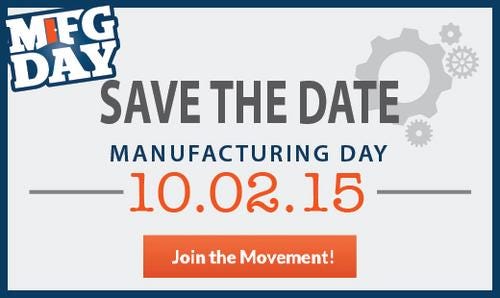October 2, 2015

Welcome to Manufacturing Day, October 2, 2015. The day comes at a time when everything is changing in manufacturing. The Fabricators & Manufacturers Association, International (FMA) designated this day to encourage events that can teach and celebrate the value of manufacturing. FMA points to 2,004 events in all that are listed on an easy-to-use map.

To paraphrase a classic Yogi Berra quote, the future of manufacturing isn’t what it used to be. Profound changes have come to the craft and art of making things. This week at PackExpo, nearly everyone we spoke with expressed a view on the changing nature of manufacturing. Here are some of their insights.
1.) It’s Not All China Any Longer
The flight to China has subsided somewhat as brand owners seek manufacturing that better supports their customers. While tons of products bound for the US are still made in China, a new paradigm has taken hold for industrial goods and for high-mix, low-volume products – build it close to the customer. The goal is to provide greater customer service and the shipping control that comes from local production. We also noted a ring of pride when employees said their products are produced locally.
2.) Everything’s Connected..But for What?
For all the talk about Industry 4.0, it seems to remain in the realm of very large manufacturers. The technology is within the reach of small- and mid-size manufacturers as automation vendors make their technologies available to a wide spectrum of customers. But smaller manufacturers are not yet equipped to effectively utilize the data coming off their machines.
As an example, conditional monitoring tends to remain in the realm of measuring how many times a machine completes a task rather than monitoring the condition of the machine. While it’s hard to make a blanket statement, most manufacturers are still monitoring equipment conditions like we monitor oil in our cars — by mileage and time, rather than by the condition of the oil itself.
3.) The End User Is Pointing to a Flexible Future
How many types of Oreos are there now? How many types of packaging do you see for Oreos? That says everything about flexible manufacturing and packaging. In the world of packaging — by extension, the world of manufacturing — the end customer is driving major changes. The retailers want custom packaging; they even want custom products themselves. It’s not just Oreos. The auto industry is also working to incorporate custom manufacturing. This is a long way from Henry Ford’s famous quote, “You can have any color you want as long as it’s black.”
READ MORE ARTICLES ON MANUFACTURING:
Across the PackExpo show floor, automation vendors explained how their newest technology advances are coming directly from customer demands. Ten or 15 years ago, these vendors were developing technology and introducing it to customers hoping they were see and appreciate (and pay for) its value. Now, again and again, I’m hearing vendors say the customer came to them with a problem, and the technology was developed as a solution.
A perfect example of this came with the retirement of the Baby-Boomer control engineers. They took decades of experience out the door when they left. The end users needed smart manufacturing systems, but their programmers were no longer in the building. Vendors have responded by creating building-block systems that require configuration, not programming — even with robotics. At PackExpo, I watched booth personnel “program” robot operations in minutes. They even turned to me and said, “Here, you try.” That’s the future of manufacturing.
What major trends/changes have you noticed in the manufacturing landscape recently? Share yours with us in the comments!

Rob Spiegel has covered automation and control for 15 years, 12 of them for Design News. Other topics he has covered include supply chain technology, alternative energy, and cyber security. For 10 years he was owner and publisher of the food magazine Chile Pepper.
About the Author(s)
You May Also Like





